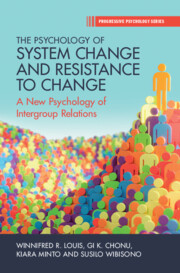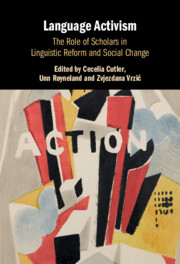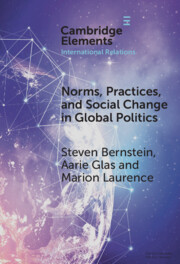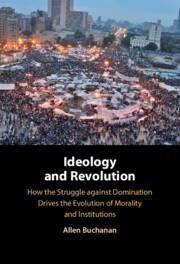Refine search
Actions for selected content:
147 results
Introduction and Overview
-
- Book:
- The Psychology of System Change and Resistance to Change
- Published online:
- 23 September 2025
- Print publication:
- 09 October 2025, pp 1-2
-
- Chapter
- Export citation
Chapter 6 - Intergroup Relations in the World Ecological and Environmental Context
- from Part II - The New Psychology of Intergroup Relations
-
- Book:
- The Psychology of System Change and Resistance to Change
- Published online:
- 23 September 2025
- Print publication:
- 09 October 2025, pp 121-139
-
- Chapter
- Export citation
Chapter 9 - Temporal Cycles and the Psychology of Time
- from Part II - The New Psychology of Intergroup Relations
-
- Book:
- The Psychology of System Change and Resistance to Change
- Published online:
- 23 September 2025
- Print publication:
- 09 October 2025, pp 185-200
-
- Chapter
- Export citation

The Psychology of System Change and Resistance to Change
- A New Psychology of Intergroup Relations
-
- Published online:
- 23 September 2025
- Print publication:
- 09 October 2025
Chapter 2 - Social Work for a Better World: Are We In-between Stories?
- from Introduction
-
-
- Book:
- Learning through Social Work Stories-That-Matter
- Published online:
- 28 August 2025
- Print publication:
- 11 September 2025, pp 20-34
-
- Chapter
- Export citation
Conclusion
-
- Book:
- Multispecies Legality
- Published online:
- 18 June 2025
- Print publication:
- 21 August 2025, pp 167-172
-
- Chapter
- Export citation
8 - Law and Social Change
-
- Book:
- Appearance, Disability and the Law
- Published online:
- 31 July 2025
- Print publication:
- 14 August 2025, pp 115-126
-
- Chapter
- Export citation
Chapter Nine - Conclusion
- from Part II
-
- Book:
- From Manners to Rules
- Published online:
- 29 August 2025
- Print publication:
- 07 August 2025, pp 308-328
-
- Chapter
- Export citation
16 - Change and International Legitimacy
- from Part V - International Legitimacy and Change
-
- Book:
- The Law and Politics of International Legitimacy
- Published online:
- 14 July 2025
- Print publication:
- 24 July 2025, pp 301-317
-
- Chapter
- Export citation
Chapter 14 - After the Reckoning
- from Part II - Politics and Debates
-
-
- Book:
- August Wilson in Context
- Published online:
- 09 June 2025
- Print publication:
- 26 June 2025, pp 174-183
-
- Chapter
- Export citation
12 - Moving towards a Manifesto
- from Part III - Struggling for Positive Human Development
-
- Book:
- Global Crisis and Insecurity
- Published online:
- 01 June 2025
- Print publication:
- 12 June 2025, pp 279-308
-
- Chapter
- Export citation

Language Activism
- The Role of Scholars in Linguistic Reform and Social Change
-
- Published online:
- 31 May 2025
- Print publication:
- 06 February 2025

Norms, Practices, and Social Change in Global Politics
-
- Published online:
- 31 March 2025
- Print publication:
- 24 April 2025
-
- Element
-
- You have access
- Open access
- HTML
- Export citation
“The wife is the mother of the husband”: Marriage, Crisis, and (Re)Generation in Botswana’s Pandemic Times
-
- Journal:
- Comparative Studies in Society and History / Volume 67 / Issue 3 / July 2025
- Published online by Cambridge University Press:
- 24 March 2025, pp. 524-546
-
- Article
-
- You have access
- Open access
- HTML
- Export citation

Ideology and Revolution
- How the Struggle against Domination Drives the Evolution of Morality and Institutions
-
- Published online:
- 13 March 2025
- Print publication:
- 20 March 2025
Chapter 20 - From Changing Contexts to Individual Change: A Lifelong Journey
-
-
- Book:
- Pillars of Developmental Psychology
- Published online:
- 14 February 2025
- Print publication:
- 20 February 2025, pp 222-232
-
- Chapter
- Export citation
Chapter 4 - Back and Forth with Life: Development of a Developmentalist
-
-
- Book:
- Pillars of Developmental Psychology
- Published online:
- 14 February 2025
- Print publication:
- 20 February 2025, pp 32-43
-
- Chapter
- Export citation
1 - Introduction
-
-
- Book:
- Language Activism
- Published online:
- 31 May 2025
- Print publication:
- 06 February 2025, pp 1-12
-
- Chapter
-
- You have access
- HTML
- Export citation
Continuity and change: A review of The United States of English - Rosemarie Ostler, The United States of English – The American Language from Colonial Times to the Twenty-First Century Oxford: Oxford University Press, 2023. Pp. 233+appendices. Hardback £21.99, ISBN 9780197647295
-
- Journal:
- English Today / Volume 40 / Issue 4 / December 2024
- Published online by Cambridge University Press:
- 04 November 2024, pp. 306-307
- Print publication:
- December 2024
-
- Article
- Export citation
Interview with Laween Palestinian Cooperative: Theatre in the Time of Genocide
-
- Journal:
- New Theatre Quarterly / Volume 40 / Issue 4 / November 2024
- Published online by Cambridge University Press:
- 10 January 2025, pp. 387-401
- Print publication:
- November 2024
-
- Article
- Export citation
